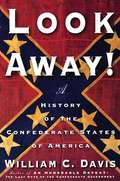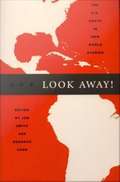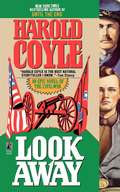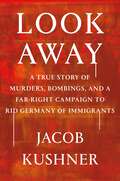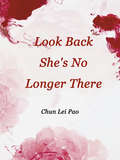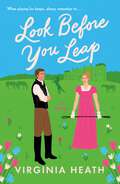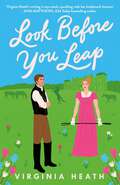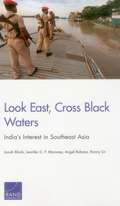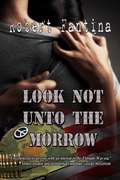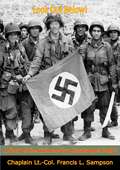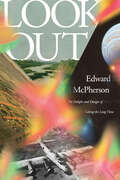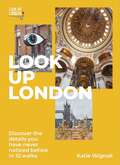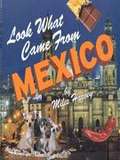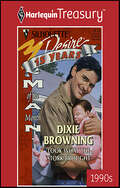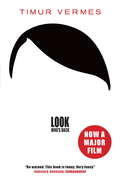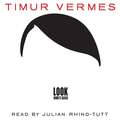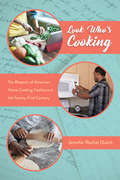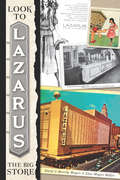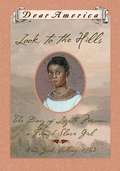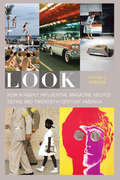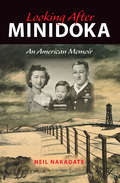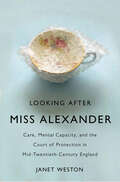- Table View
- List View
Look Away!
by William C. DavisWilliam C. Davis, one of America's best Civil War historians, here offers a definitive portrait of the Confederacy unlike any that has come before. Drawing on decades of writing and research among an unprecedented number of archives, Look Away! tells the story of the Confederate States of America not simply as a military saga (although it is that), but rather as a full portrait of a society and incipient nation. The first history of the Confederacy in decades, the culmination of a great scholar's career, Look Away! combines politics, economics, and social history to set a new standard for its subject. Previous histories have focused on familiar commanders such as Robert E. Lee and Stonewall Jackson, but Davis's canvas is much broader. From firebrand politicians like Robert Barnwell Rhett and William L. Yancey, who pushed for secession long before the public supported it; to Dr. Samuel Cartwright, who persuaded many Southerners of the natural inferiority of their slaves; to the women of Richmond, who rioted over bread shortages in 1863, Davis presents a rich new face of the Confederate nation. He recounts familiar stories of battles won and lost, but also little-known economic stories of a desperate government that socialized the salt industry, home-front stories of the rangers and marauders who preyed on their fellow Confederates, and an account of the steady breakdown of law, culminating in near anarchy in some states. Never has the Confederacy been so vividly brought to life as a full society, riven with political and economic conflicts beneath its more loudly publicized military battles. Davis's astonishingly thorough primary research has ranged across the 800-odd newspapers that were in operation during the war, but also across the personal papers of over a hundred Southern leaders and ordinary citizens. He quotes from letters and diaries throughout the narrative, revealing the Confederacy through the words of the Confederates themselves. Like any society, especially in the early stages of nation-building and the devastating stages of warfare, the Confederacy was not one thing but many things to many people. One thing, however, was shared by all: the belief that the South offered a necessary evolution of American democracy. Look Away! offers a dramatic and definitive account of one of America's most searing episodes.
Look Away!: The U. S. South in New World Studies
by Jon Smith Deborah CohnLook Away! considers the U. S. South in relation to Latin America and the Caribbean. Given that some of the major characteristics that mark the South as exceptional within the United States--including the legacies of a plantation economy and slave trade--are common to most of the Americas, Look Away! points to postcolonial studies as perhaps the best perspective from which to comprehend the U. S. South. At the same time it shows how, as part of the United States, the South--both center and margin, victor and defeated, and empire and colony--complicates ideas of the postcolonial. The twenty-two essays in this comparative, interdisciplinary collection rethink southern U. S. identity, race, and the differences and commonalities between the cultural productions and imagined communities of the U. S. South and Latin America. Look Away! presents work by respected scholars in comparative literature, American studies, and Latin American studies. The contributors analyze how writers--including the Martinican Edouard Glissant, the Cuban-American Gustavo Prez Firmat, and the Trinidad-born, British V. S. Naipaul--have engaged with the southern United States. They explore William Faulkner's role in Latin American thought and consider his work in relation to that of Gabriel Garca Mrquez and Jorge Luis Borges. Many essays re-examine major topics in southern U. S. culture--such as race, slavery, slave resistance, and the legacies of the past--through the lens of postcolonial theory and postmodern geography. Others discuss the South in relation to the U. S. -Mexico border. Throughout the volume, the contributors consistently reconceptualize U. S. southern culture in a way that acknowledges its postcolonial status without diminishing its distinctiveness. Contributors. Jesse Alemn, Bob Brinkmeyer, Debra Cohen, Deborah Cohn, Michael Dash, Leigh Anne Duck, Wendy Faris, Earl Fitz, George Handley, Steve Hunsaker, Kirsten Silva Gruesz, Dane Johnson, Richard King, Jane Landers, John T. Matthews, Stephanie Merrim, Helen Oakley, Vincent Prez, John-Michael Rivera, Scott Romine, Jon Smith, Ilan Stavans, Philip Weinstein, Lois Parkinson Zamora
Look Away: A History of the Confederate States of America
by Harold CoyleThis Civil War saga from military novelist Coyle is about two brothers from New Jersey who find themselves on opposite sides of the war.
Look Away: A True Story of Murders, Bombings, and a Far-Right Campaign to Rid Germany of Immigrants
by Jacob KushnerA thrilling narrative investigation into the National Socialist Underground (NSU)—a German terror organization that targeted immigrants—and how a government failed to stop it. Not long after the Berlin Wall fell, three teenagers became friends in the East German town of Jena. It was a time of excitement, but also of deep uncertainty: some four million East Germans found themselves out of work. The friends began attending far-right rallies with people who called themselves National Socialists: Nazis. And, like the Hitler-led Nazis before them, they blamed minorities for their ills. From 2000 to 2011, they embarked on the most horrific string of white nationalist killings since the Holocaust. Their target: immigrants. Look Away follows Beate Zschäpe and her two accomplices—and sometimes lovers—as they became radicalized within Germany&’s far-right scene, escaped into hiding, and carried out their terrorist spree. Unable to believe that the brutal killings and bombings were being carried out by white Germans, police blamed—and sometimes framed—the immigrants instead. Readers meet Gamze Kubaşık, whose family emigrated from Turkey to seek safety, only to find themselves in the terrorists&’ sights. It also tracks Katharina König, an Antifa punk who would help expose the NSU and their accomplices to the world. A masterwork of reporting and storytelling, Look Away reveals how a group of young Germans carried out a shocking spree of white supremacist violence, and how a nation and its government ignored them until it was too late.
Look Back, She's No Longer There: Volume 1 (Volume 1 #1)
by Chun LeiPaoFrom the time he had saved her when she was young, she had regarded him as everything.To become the best sword in his hands, to pacify these mountains and rivers for him.He had overturned the world, ascended the throne, and given her the promise of a lifetime.As for her, she had been gifted to the vassal lord and would never again be reunited with him.Years later, he suddenly missed the woman who had fought for him in the world and made him more tea.Looking at each other from afar, she was already a mother.When she saw him again, in order to protect her husband's life, she committed suicide in front of him and fell off the platform.In this golden age, there was no longer a smile on her face. At that moment, he had gone mad …
Look Before You Leap: A Novel (Miss Prentice's Protegees)
by Virginia HeathIn this hilarious second installment of a Regency romance series, a single lord is forced to settle down...and when a houseparty brings a happy-go-lucky lady's companion his way, his grumpy heart is unexpectedly warmed.Nine years ago, Lord Guy Harrowby, Viscount Wennington, was publicly humiliated by a failed and reckless romantic gesture. Despite this, his mother clings to the promise he made her then: that she would have a house full of grandchildren by his thirtieth birthday. Still single, embittered, and swiftly approaching thirty, Guy's work is his life. In desperation, his mother blindsides Guy with a weeklong house party at his estate filled with annoying debutantes, all competing to be his wife.After failing as a governess, Lottie Travers is struggling as a lady’s companion. Raised in an all-male household, she’s developed habits that get her dismissed. Even after years of Miss Prentice’s teachings of how to be a lady, she climbs trees better than she embroiders and can’t resist riding horses astride, in breeches. But with the family farm in trouble, and her father now in dire need of her wages, she’s determined to conquer her wildness once and for all.Even with his home full of eligible women, there is only one who catches Guy’s eye—though he tries to deny it. For Lottie, succeeding in her new role proves difficult when the Wennington estate is filled with horses, and a spark ignites between her and the grumpy lord. Will they remain stuck in their ways, or learn that they may just be the perfect match?
Look Before You Leap: A brand-new hilarious and heartwarming Regency romp! (Miss Prentice’s Proteges)
by Virginia Heath'A refreshing array of dazzling wit, hidden depths, lip curling humour and heartmelting fun, in all its entangling intimacy!!'⭐ ⭐ ⭐ ⭐ ⭐ reader praise for the Merriwell Sisters series!'Virginia Heath's fun characters and situations will have you laughing out loud!' SABRINA JEFFRIES'Filled with fabulously British banter, wit, and heart' EVIE DUNMORE'Heath is carving a name for herself in historical rom-coms' BOOKLIST starred reviewLOOK BEFORE YOU LEAP is the second in a new Regency romp of a series from the author of the Merriwell Sisters series! In this hilarious historical rom-com, a single lord is forced to settle down...and when a houseparty brings a happy-go-lucky lady's companion his way, his grumpy heart is unexpectedly warmed.________________________Nine years ago, Lord Guy Harrowby was publicly humiliated by a failed romantic gesture. Now, with the clock ticking on a promise he made to his mother to make her a grandmother by his thirtieth birthday, Guy is horrified to see his incorrigible mother taking matters into her own hands: she's organised a week-long house party at his estate . . . with every debutante she can think of. Lottie Travers is not a very good lady's companion. Despite years of trying, she still climbs trees better than she embroiders, and would always rather be riding horses. But now, with her family's finances relying on her wages, she's determined to conquer her wildness once and for all. Overwhelmed with eligible women, there is only one who catches Guy's eye, no matter how hard he tries to deny it. For Lottie, succeeding in her job proves difficult when the Wennington estate is filled with horses and there is a definite spark between her and the grumpy lord. Neither of them is quite what the other expected, but could they in fact be the perfect match?________________________Readers LOVED the Merriwell Sisters!!'An utterly heartwarming and hilarious romp through regency England . . . Virginia Heath's new series is the perfect blend of humour and romance that Bridgerton fans will fall head over heels for' 5⭐ NetGalley review'A fresh, fun and a totally original take on the regency romance genre . . . the witty banter is brilliant and so entertaining! . . . I can't wait to read more from this author' 5⭐ NetGalley review'I absolutely loved this book . . . A historical romance with humour. Looking forward to the next book by Virginia Heath' 5⭐ NetGalley review'What a fun story! . . . Hugh and Minerva have fantastic chemistry, and they send up sparks every time they are on the page together . . . A great read all the way around!' 5⭐ NetGalley review'The first in a new series & boy what a starter, it had me hooked & giggling from the first page . . . If you want a humorous, entertaining often farcical yet romantic read look no further' 5⭐ NetGalley review'I loved, loved, loved this story!' 5⭐ NetGalley review
Look East, Cross Black Waters
by Angel Rabasa Jennifer D. Moroney Bonny Lin Jonah BlankIndia's core goals for Southeast Asia are in basic harmony with those of the United States, including regional stability, peaceful settlement of territorial disputes, and containment of radicalism Still, America should not expect India to enter any sort of alliance, nor join any coalition to balance against China, but should demonstrate strategic patience and willingness to cultivate a long-term relationship.
Look Not Unto The Morrow
by Robert FantinaIn "Look Not Unto the Morrow," innocence shattered and ultimate redemption are portrayed against the backdrop of the Vietnam War and the turbulent sixties. The story follows the lives of three young people as they experience love and war. Roger Gaines is the promising young college student, drafted into the army and traumatized by his experiences in basic training and Vietnam. Pam Wentworth is the loving girlfriend he leaves behind, who evolves from naive college student, to political activist, to radical anarchist. Michelle Healy is the young woman Roger meets when he returns home, who loves him unconditionally when he can no longer love himself.
Look Out Below!: A Story of the Airborne by a Paratrooper Padre
by Chaplain Lt.-Col. Francis L. SampsonFirst published in 1958, this book tells the spellbinding story of “one of the remarkable priests of God who leaped behind enemy lines and into the midst of combat with no weapon other than the sword of the spirit, no protection other than the shield of faith.“Here is the story of the airborne troopers told by the one who knew them best and with insights only a priest could possess.“It is sometimes humorous, sometimes tragic, often heroic, but always honest and inspiring as seen through the understanding and sympathetic eyes of the paratrooper padre.” (Lt.-Gen. Thomas F. Hickey)Richly illustrated throughout with photos.
Look Out: The Delight and Danger of Taking the Long View
by Edward McPherson"A charming, idiosyncratic meditation on the human urge to see further, and more, in this cultural history of the 'aerial view' . . . McPherson makes an elliptical and enchanting case for reinserting wherever possible the ground-level, human perspective . . . Redolent with insights into the ethical quandary of history-making, as well as the author&’s own sense of awe at the full sweep of the human story, this is a wonder."—Publishers Weekly, starred reviewAs if Borges and Didion took a tour with Sebald through the beauty and terror of our present and past, Look Out is a profound and prismatic investigation of taking the long view.Look Out is an exploration of long-distance mapping, aerial photography, and top-down and far-ranging perspectives—from pre–Civil War America to our vexed modern times of drone warfare, hyper-surveillance at home and abroad, and quarantine and protest. Blending history, reporting, personal experience, and accounts of activists, programmers, spies, astronauts, artists, inventors, and dreamers, Edward McPherson reveals that to see is to control—and the stakes are high for everyone.The aerial view—a position known in Greek as the catascopos, or &“the looker-down&”—is a fundamentally privileged perspective, inaccessible to those left on the ground. To the earthbound, (in)sights from such rarified heights convey power and authority. McPherson casts light on our fetishization of distance as a path to truth and considers the awe and apocalypse of taking the long view.
Look Up London: Discover the details you have never noticed before in 10 walks
by Katie WignallA refreshing guide to discovering the hidden details of London with 10 fully guided walking routes from London's leading tour guide Look Up London. Have you ever noticed London's tiniest public sculpture? Or wondered why there are strange cone-shaped structures on the fanciest historic homes? Did you know that the Tower of London used to be a zoo, or about the now defunct London railway that transported over 200,000 people to their final resting place? These are just some of the fascinating details that Blue Badge Tourist guide Katie Wignall reveals in this absorbing guide to the secrets of London hidden in plain sight. Take a journey through London's rich past with these 10 fully guided walking routes and discover a whole world of incredible history hiding above your eye-line, just waiting to be spotted. From the saucy scandals of Covent Garden to stories of power and intrigue from the City, atmospheric pubs to hidden Roman remains, London is a city bursting with captivating stories which are etched into its very architecture. So, Look Up and discover a London you have never seen before.
Look Up London: Discover the details you have never noticed before in 10 walks
by Katie WignallA refreshing guide to discovering the hidden details of London with 10 fully guided walking routes from London's leading tour guide Look Up London. Have you ever noticed London's tiniest public sculpture? Or wondered why there are strange cone-shaped structures on the fanciest historic homes? Did you know that the Tower of London used to be a zoo, or about the now defunct London railway that transported over 200,000 people to their final resting place? These are just some of the fascinating details that Blue Badge Tourist guide Katie Wignall reveals in this absorbing guide to the secrets of London hidden in plain sight. Take a journey through London's rich past with these 10 fully guided walking routes and discover a whole world of incredible history hiding above your eye-line, just waiting to be spotted. From the saucy scandals of Covent Garden to stories of power and intrigue from the City, atmospheric pubs to hidden Roman remains, London is a city bursting with captivating stories which are etched into its very architecture. So, Look Up and discover a London you have never seen before.
Look What Came from Mexico
by Miles HarveyThis series meets National Curriculum Standards for: Social Studies: Culture Global Connections People, Places, & Environments
Look What the Stork Brought (Man of the Month)
by Dixie BrowningMR. DECEMBERInstant Father: Former detective Joe Dana had a weakness for beautiful women-not pudgy babies!Earth Mother: Sophie Bayard knew all about natural childbirth-she just didn't expect a handsome stranger to practically deliver her baby in a vegetable garden!Little Miss Fatcheeks: Could this tiny dynamo hook Sophie a husband?Joe planned to hightail it back to Texas once he retrieved an heirloom from the brand-new mother, but before this bachelor knew it, he was strutting around like the proud papa. Uh-oh! And now these designing women were trying to turn this nonmarrying man into Father of the Year!MAN OF THE MONTH: Beneath his tough exterior beats a tender heart.
Look Who's Back
by Timur VermesTHE SMASH-HIT HITLER SATIRE - MORE THAN 3 MILLION COPIES SOLD"A brilliant book" RUSSELL KANE "Brilliant and hilarious" KEN FOLLETTA box-office-hit film now available on NETFLIXA two-part BBC Radio 4 Dramatisation directed by and starring David Threlfall (Shameless)Berlin, Summer 2011. Adolf Hitler wakes up on a patch of open ground, alive and well. Things have changed - no Eva Braun, no Nazi party, no war. Hitler barely recognises his beloved Fatherland, filled with immigrants and run by a woman. People certainly recognise him, albeit as a flawless impersonator who refuses to break character. The unthinkable, the inevitable happens, and the ranting Hitler goes viral, becomes a YouTube star, gets his own T.V. show, and people begin to listen. But the Führer has another programme with even greater ambition - to set the country he finds a shambles back to rights. Look Who's Back stunned and then thrilled 1.5 million German readers with its fearless approach to the most taboo of subjects. Naive yet insightful, repellent yet strangely sympathetic, the revived Hitler unquestionably has a spring in his step.Translated from German by Jamie Bulloch
Look Who's Back
by Timur VermesTHE SMASH-HIT HITLER SATIRE - MORE THAN 3 MILLION COPIES SOLD"A brilliant book" RUSSELL KANE "Brilliant and hilarious" KEN FOLLETTA box-office-hit film now available on NETFLIXA two-part BBC Radio 4 Dramatisation directed by and starring David Threlfall (Shameless)Berlin, Summer 2011. Adolf Hitler wakes up on a patch of open ground, alive and well. Things have changed - no Eva Braun, no Nazi party, no war. Hitler barely recognises his beloved Fatherland, filled with immigrants and run by a woman. People certainly recognise him, albeit as a flawless impersonator who refuses to break character. The unthinkable, the inevitable happens, and the ranting Hitler goes viral, becomes a YouTube star, gets his own T.V. show, and people begin to listen. But the Führer has another programme with even greater ambition - to set the country he finds a shambles back to rights. Look Who's Back stunned and then thrilled 1.5 million German readers with its fearless approach to the most taboo of subjects. Naive yet insightful, repellent yet strangely sympathetic, the revived Hitler unquestionably has a spring in his step.Translated from German by Jamie Bulloch
Look Who's Back
by Timur VermesBerlin, Summer 2011. Adolf Hitler wakes up on a patch of open ground, alive and well. Things have changed - no Eva Braun, no Nazi party, no war. Hitler barely recognises his beloved Fatherland, filled with immigrants and run by a woman. People certainly recognise him, albeit as a flawless impersonator who refuses to break character. The unthinkable, the inevitable happens, and the ranting Hitler goes viral, becomes a YouTube star, gets his own T.V. show, and people begin to listen. But the Führer has another programme with even greater ambition - to set the country he finds a shambles back to rights. Look Who's Back stunned and then thrilled 1.5 million German readers with its fearless approach to the most taboo of subjects. Naive yet insightful, repellent yet strangely sympathetic, the revived Hitler unquestionably has a spring in his step.(P)2014 Quercus Publishing Ltd
Look Who's Cooking: The Rhetoric of American Home Cooking Traditions in the Twenty-First Century (Folklore Studies in a Multicultural World Series)
by Jennifer Rachel DutchHome cooking is a multibillion-dollar industry that includes cookbooks, kitchen gadgets, high-end appliances, specialty ingredients, and more. Cooking-themed programming flourishes on television, inspiring a wide array of celebrity chef–branded goods even as self-described “foodies” seek authenticity by pickling, preserving, and canning foods in their own home kitchens. Despite this, claims that “no one has time to cook anymore” are common, lamenting the slow extinction of traditional American home cooking in the twenty-first century.In Look Who's Cooking: The Rhetoric of American Home Cooking Traditions in the Twenty-First Century, author Jennifer Rachel Dutch explores the death-of-home-cooking narrative, revealing how modern changes transformed cooking at home from an odious chore into a concept imbued with deep meanings associated with home, family, and community.Drawing on a wide array of texts—cookbooks, advertising, YouTube videos, and more—Dutch analyzes the many manifestations of traditional cooking in America today. She argues that what is missing from the discourse around home cooking is an understanding of skills and recipes as a form of folklore. Dutch’s research reveals that home cooking is a powerful vessel that Americans fill with meaning because it represents both the continuity of the past and adaptability to the present. Home cooking is about much more than what is for dinner; it’s about forging a connection to the past, displaying the self in the present, and leaving a lasting legacy for the future.
Look for the Silver Lining
by June FrancisNo one is spared from the heartache of warAs the Blitz destroys lives in Liverpool, three sisters are forced to make difficult choices to protect themselves and those they love. When Nellie Callaghan marries her love in secret, it causes a rift in the family. But when the bombs drop on Liverpool grievances must be put aside as the people of the city are brought to despair. Nellie’s mother is killed and her sister Lottie is injured, while her other sister Babs runs away to join the WLA. It falls to Nellie to care for the family. Despite the suffering that the war brings, it is trouble on the homefront that leads to further hardship for each of the sisters. Before the war is over, each of the Callaghans will have faced heartbreak and sacrifice. But amongst the sadness they will find some joy, and never giving up hope for a brighter future.
Look to Lazarus: The Big Store (Landmarks)
by David Meyers Elise Meyers Walker Beverly MeyersFor more than 150 years, F&R Lazarus & Company was the heart of downtown Columbus. Headed by the "first family of American retailing"? with an eye for flair and a devotion to the customer, this uniquely midwestern institution won the hearts and minds of a community. Look to Lazarus draws on the memories of those who worked and shopped in this grand emporium to tell the unlikely story of a love affair between a city and a store. It was a love affair born of the solemn promise "You can always take it back to Lazarus, no questions asked."?
Look to the Hills: The Diary of Lozette Moreau, A French Slave Girl (Dear America)
by Patricia C. MckissackThe Newbery Honor-winning author presents this story of an orphaned slave girl who arrives with her French masters in New York Colony at the end of the French-Indian War.
Look: How a Highly Influential Magazine Helped Define Mid-Twentieth-Century America
by Andrew L. YarrowAndrew L. Yarrow tells the story of Look magazine, one of the greatest mass-circulation publications in American history, and the very different United States in which it existed. The all-but-forgotten magazine had an extraordinary influence on mid-twentieth-century America, not only by telling powerful, thoughtful stories and printing outstanding photographs but also by helping to create a national conversation around a common set of ideas and ideals. Yarrow describes how the magazine covered the United States and the world, telling stories of people and trends, injustices and triumphs, and included essays by prominent Americans such as Martin Luther King Jr. and Margaret Mead. It did not shy away from exposing the country&’s problems, but it always believed that those problems could be solved.Look, which was published from 1937 to 1971 and had about 35 million readers at its peak, was an astute observer with a distinctive take on one of the greatest eras in U.S. history—from winning World War II and building immense, increasingly inclusive prosperity to celebrating grand achievements and advancing the rights of Black and female citizens. Because the magazine shaped Americans&’ beliefs while guiding the country through a period of profound social and cultural change, this is also a story about how a long-gone form of journalism helped make America better and assured readers it could be better still.
Looking After Minidoka: An American Memoir (Break Away Bks.)
by Neil NakadateA &“clear-eyed, carefully researched but nonetheless passionate book&” that is &“rich with the closely observed details of internment camp life&” (Lauren Kessler, author of Stubborn Twig: Three Generations in the Life of a Japanese American Family). During World War II, 110,000 Japanese Americans were removed from their homes and incarcerated by the US government. In Looking After Minidoka, the &“internment camp&” years become a prism for understanding three generations of Japanese-American life, from immigration to the end of the twentieth century. Nakadate blends history, poetry, rescued memory, and family stories in an American narrative of hope and disappointment, language and education, employment and social standing, prejudice and pain, communal values and personal dreams. &“Poetic yet sharply honest, the family story unfolds within the larger context of the national saga. You&’ll wince but read it anyway. Your soul will be better for it.&” —Nuvo &“This book is highly readable and contains fascinating details not usually covered in other books on Japanese-American history.&” —Oregon Historical Quarterly
Looking After Miss Alexander: Care, Mental Capacity, and the Court of Protection in Mid-Twentieth-Century England (States, People, and the History of Social Change)
by Janet WestonIn July 1939, at the Royal Courts of Justice in London, fifty-nine-year-old Beatrice Alexander was found incapable of managing her own property and affairs. Although Alexander and those living with her insisted that she was perfectly well, the official solicitor took control of her home and money, evicted her “friends,” and hired a live-in companion to watch over her. Alexander remained legally incapable for the next thirty years. In the mid-twentieth century, Alexander was one of about thirty thousand people in England and Wales who were, at any time, legally “incapable” and under the auspices of what is now the Court of Protection. Focusing on the period between the 1920s and the 1960s, Looking After Miss Alexander explains the workings of the court, using Alexander’s unusual case to consider the complexities of this aspect of mental health law. Drawing on Court of Protection archives – some of which were made publicly available for the first time in 2019 – and micro-historical methods, Janet Weston also highlights the role of chance, subjectivity, and uncertainty in shaping how events unfolded then, and the stories we tell about those events today.An engaging and accessible history of mental capacity law, Looking After Miss Alexander examines ideas of citizenship and welfare, gender and vulnerability, care and control, and the role of the state. It also offers reflections on historical research and writing itself.
